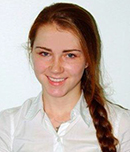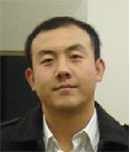Day 3 :
- Mastering Medicinal Chemistry
Chair
sfdbsab
ASDb
Session Introduction
Minying Cai
Arizona Cancer Center
USA
Title: Design of novel potent and selective agonists at the melanocortin1 receptor

Biography:
Minying Cai is currently a research professor in the Department of Chemistry and Biochemistry at the University of Arizona. She has been working in the Chemistry & Biochemistry department for more than 16 years and has more than 100 publications in the area of novel drug discovery for obesity, diabetes, cancer and pain. She received the Ph.D. at the University of Arizona in Biochemistry and Molecular Biophysics in 2004. Before that, she had been working in Shanghai Institute of Materia Medica; Shanghai Research Center of Biotechnology in Chinese Academy of Sciences.
Abstract:
Melanoma is a lethal form skin cancer which causes more than 10,000 deaths in the United States annually. Skin pigmentation, which is regulated by the melanocortin 1 receptor (MC1R), is an effective protection against melanoma. However, the endogenous MC1R agonists and some of its analogues lack selectivity to MC1R and can have side effects through other melanocortin receptors. Here we report the development of potent and selective hMC1R agonists using state of computational chemistry combined with chimeric receptor studies. We successfully developed a potent selective hMC1R selective agonist with at least 100/300/15-fold selectivity towards hMC3R/hMC4R/hMC5R respectively. The binding affinity for the novel peptides is 25 nM. Key interactions between this peptide and hMC1R were identified through NMR studies and molecular docking studies. The bioavailability studies reveal that this novel peptide is an ideal peptide ligand for the melanoma prevention.
Eko Aditya
Vrije Universiteit Amsterdam
The Netherlands
Title: Molecular dynamics study of autotaxin with potential allosteric inhibitors

Biography:
Eko Aditya Rifai is currently a PhD student in Computational Toxicology at Vrije Universiteit Amsterdam, after pursuing his Bachelor’s and Master’s degrees at Universitas Indonesia and University of Glasgow, respectively. His research interests are using computational methods to discover potential inhibitors of enzymes correlating in human diseases and to examine interactions of drug candidates with target and off-target proteins.
Abstract:
Autotaxin is an enzyme catalyzing the synthesis of lysophosphatidic acid, a lipid signaling molecule involved in several cellular responses such as cellular survival, proliferation, differentiation, and migration. Nevertheless, abnormal expression of autotaxin is correlated with numerous cancer and fibrosis, therefore autotaxin is considered as drug target over years. All of currently studied autotaxin inhibitors bind in the orthosteric site of autotaxin. However, developing allosteric inhibitors can be valuable based on pharmacological aspects, such as more target-specific and cause less side effects. In this work, dynamics of autotaxin in free form and in complex with six ligands are studied by using molecular dynamics approach in order to observe the effect of allosteric binding to orthosteric site. As a result, four of six ligands found to affect the positions of orthosteric site significantly.

Biography:
Manjinder Singh is a Ph.D. research scholar in the Department of Pharmaceutical Sciences and Drug Research, Punjabi University, Patiala under the supervision of Dr. Om Silakari (Assistant Professor). He has completed his M. Pharmacy in the same department (2010–2012). His area of specialization is synthesis and biological evaluation of medicinal and organic compounds against Alzheimer’s diseases. He has about 08 publications under his credit on Flavones, Acetylcholinesterase, P2X7, kinase inhibitors like Syk, ZAP-70. He is working as a Senior Research Fellow of ICMR, Delhi in Department of Pharmaceutical Sciences and Drug Research, Punjabi University, Patiala.
Abstract:
Development of Multi-Target Directed Ligands (MTDLs) has emerged as a promising approach for targeting complex pathophysiology of Alzheimer’s disease (AD). Following this approach, a new series of 2-phenyl-1-benzopyran-4-one derivatives was designed, synthesized and biologically evaluated as inhibitors of acetylcholinesterases (AChEs), advanced glycation end products formation (AGEs) and also for their radical scavenging activity. The in vitro studies showed that the majority of synthesized derivatives inhibited acetylcholinesterase (AChE) with IC50 values in the nanomolar range. Among them, inhibitors 7h, 7k and 7a, strongly inhibited AChE, with IC50 value of 6.33, 7.56 and 11.0 nM, respectively, and were more potent than the reference compound donepezil. Moreover, the molecular docking study displayed that most potent compounds simultaneously bind to catalytic active site and peripheral anionic site of AChE. Besides, these compounds also exhibited greater ability to inhibit advanced glycation end products formation with additional radical scavenging property. Thus, 2-phenyl-1-benzopyran-4-one derivatives might be the promising lead compound as potential poly-functional anti-Alzheimer’s agents.
- Novel Drug Design
Session Introduction
Thorsten Nowak
C4X Discovery Manchester
UK
Title: Conformational design in medicinal chemistry - An important under-utilised opportunity

Biography:
Thorsten Nowak completed his PhD from the University of Cambridge (UK) in the areas of aldol methodology and natural product synthesis. In 1996, he joined AstraZeneca where he worked on all stages of drug discovery from target to candidate selection in medicinal chemistry as team leader and project manager. His keen interest in new technologies motivated a career move from big pharma to platform technology business in 2012 when he joined C4X Discovery. In his current role, he is responsible for all internal drug discovery projects at C4X Discovery as well as continued development of the technology in the context of application to drug discovery.
Abstract:
With the expertise of the team from C4X Discovery, this workshop will explore how conformational insights can impact rational design in drug discovery. A brief introduction into techniques available to experimentally determine molecular conformations will follow a discussion of their associated advantages and limitations. Subsequently, control factors of conformational behavior will be introduced and their utility exemplified with case studies that will explore the principles of conformational design. The workshop participant will gain an outline understanding of the control of conformational features and how such knowledge can be used to complement alternative design strategies and technologies.
- Computer Aided Drug Design-CADD
Session Introduction
Simone V. Bigi
Takeda California, Inc.,
USA
Title: Exploiting Unique Interactions in the MKK3/6 and ASK1 Kinase Active Sites through Computer-Aided Drug Design

Biography:
Simone Verene Bigi completed her BS from University of Notre Dame in South Bend, Indiana.
Abstract:
Since the early 1990’s, the concept of structure-based drug design has been demonstrated on a wide array of protein targets, becoming an established and integral part of drug discovery and lead optimization. While now synonymous with this concept, computer-aided modeling is widely recognized as a seminal aspect of structurally enabled drug discovery programs. The ubiquitous exposure to structural information has spawned a scientific enlightenment around the details and nuances of protein structural information. Kinases are one of the most extensively studied protein families based on the vast number of structures currently available in the Protein Data Bank. Although they share similar architectures and substrates, it is still quite common to identify unique interactions within these proteins that can yield highly selective inhibitors. My talk will describe the use of computer-aided drug design in the context of optimizing novel inhibitors of the two kinases: MAP Kinase Kinase isoforms 3/6 (MKK3/6) and the Apoptosis Signal-Regulating Kinase 1 (ASK1). Each of these kinases is found within the MAPK pathway and contain unique residues and interactions in the active site. Using structure-based modeling, these differences were exploited to enhance inhibitor potency and selectivity. These efforts yielded highly efficient and selective tool compounds that were valuable in testing key pharmacological hypotheses in the areas of immunological and cardiovascular diseases.
- Hyphenated Chromatographic Techniques In Drug Discovery
Session Introduction
Babak Daneshfard
Shiraz University of MedicalSciences
Iran
Title: Boundary-state light emission quantums in biomolecules

Biography:
Babak Daneshfard is a PhD candidate in Shiraz University of Medical Sciences (SUMS). He has published more than 10 papers in reputed journals and has been serving as a reviewer of CAM journals. He is also an expert in Mind-Body Medicine.
Abstract:
If light is to be emitted from substance(s) as through means of jumping down of an electron from a higher position to a lower energy level, as defined by modern physics mainstream phenomenalism, then the collocation of an arbitrarily chosen “central” atom with its adjacent atoms would most naturally provide a hypothetical matrix for observations and calculations to be carried out regarding how much the boundary-atom schemes can probably replace the already routine procedures in the workings of optical physics. True to the fact is that ordinary large-sized molecules (with from 100 to 1000 atoms) mostly having their origin in relatively stable biomolecular structures may –with some computational difficulties provide some sort of continuum for studying optical links through neighboring atoms vibrations without specific recourse, for example, to yet other atoms whose gradually increasing distance to the “central” atom brings in parameters of beyond-5-Å non-boundary conditions that are normally too complicated to be brought out by Eigen functions as Eigen values. There are of course, molar fractions of vibration quality atoms again to be constructurally role-playing in nearly exact determination of the amount of error arising from the actuality that biomolecular atomic regionalization gets out of the state of arbitrariness. In case this parameter were not to be detectable, adjustable (through adding on or deleting metal atoms on recipient sites on the said large molecules, or: alternatively, through being in possession of optic isomers) or even removable (say, by means of picking totally different biomolecules), the clamped string of atoms considered to be in the same region should have, consequently, not provided constraints to assist in building up even the differential equations themselves.
- Innovations in Pharmacological Studies & Drug Development
Session Introduction
Arvi Rauk
University of Calgary
Canada
Title: Inhibition of amyloid beta peptide oligomerization: Empirical and ab initio studies

Biography:
Abstract:
- Drug Discovery & Treatment Towards Infectious Diseases
Session Introduction
Ravindra K Pandey
Roswell Park Cancer Institute
USA
Title: Dual-function near-infrared (nir) photosensitizer for fluorescence imaging and photodynamic therapy (pdt) of cancer

Biography:
Ravindra K Pandey has worked on investigating the utility of porhyrin-based compounds and nanoparticles (ORMOSIL, polyacrylamide, gold, rHDL, chitosan and polymers) as multifunctional agents for cancer-imaging and therapy. One of the photosensitizers (HPPH) synthesized in his laboratory is currently undergoing phase II human clinical trials for head and neck cancer, and other two candidates which show potential for tumor imaging by PET and near infrared (NIR) fluorescenceguided photodynamic therapy (including surgery) are at the advanced stages of preclinical studies. The current focus of his laboratory is also to explore the use of PDT in combination with other treatment modalities (e. g., surgery and chemotherapy).
Abstract:
We report herein, the synthesis and biological efficacy of near-infrared (NIR), bacteriochlorin analogs: 3-(1’-butyloxy)ethyl- 3-deacetyl-bacteriopurpurin-18-N-butylimide methyl ester and the corresponding carboxylic acid. In in vitro assays, compared to its methyl ester analog, the corresponding carboxylic acid derivative showed higher photosensitizing efficacy. However, due to drastically different pharmacokinetics in vivo, the desired PS (HPLC purity >99%) showed higher tumor uptake and long-term tumor cure than the corresponding carboxylic acid (HPLC purity > 96.5%) in BALB/c mice bearing colon 26 tumors. Isomerically pure R- and S- isomers of the desired analog (HPLC purity >99%) under similar treatment parameters showed identical efficacy in vitro and in vivo. In addition, the NIR photosensitizer (PS) showed limited skin phototoxicity, and provides an additional advantage over the clinically approved chemically complex hematoporphyrin derivative (Photofrin) as well as other porphyrin-based PDT agents, which makes it a promising dual-function agent for fluorescence-guided surgery with an option of phototherapy of cancer.
- Drug Design and Chemistry: Cancer Studies
Session Introduction
Nicolas Moitessier
McGill University
Canada
Title: Fitted, an evolving docking programs addressing unmet medicinal chemistry needs

Biography:
Nicolas Moitessier is an Associate Professor at McGill University, Montréal, Canada. He received his undergraduate training and his PhD from Université Henri Poincaré-Nancy I (France) under the guidance of Dr. Yves Chapleur within the Groupe SUCRES. He carried out thesis research on computer-aided design and synthesis of carbohydrate-based biologically relevant molecules. He was first involved in the design and preparation of IP3 and Adenophostin A mimics using Sharpless asymmetric dihydroxylation as a key reaction. In collaboration with a theoretical chemistry group (headed by Dr. Maigret), he then focused on the computer-aided design and synthesis of carbohydrate-based antagonists of integrins.
Abstract:
Docking methods have been prominent in the discovery of novel drugs. Over the 15 years ago, we have been developing a docking program which has been modified to address unmet needs in medicinal chemistry. Initially, our applications of docking programs to integrin antagonists, BACE-1 inhibitors, and aminoglycosides binding to bacterial RNA revealed the limitations of available docking programs, which were essentially docking flexible ligands to rigid proteins. Over the following year, we developed our own program, Fitted, implementing algorithms for protein flexibility, displaceable water molecules, and ligand-based pharmacophore-oriented docking. Other medicinal chemistry projects motivated most of the concepts and implementation within an ever-evolving docking program. We will present examples of medicinal chemistry-driven implementations such as methods considering drug-zinc coordination and its effect on the pKa of surrounding residues, for HDAC inhibitor design, routines to identify reactive groups and form bonds with a given residue to enable the development of covalent prolyl oligopeptidase (POP) inhibitors, methods to compute transition states while docking for studying the metabolism of POP inhibitors by cytochrome P450 enzymes (CYPs) and others.
Jagroop Kaur
Guru Nanak Dev University
India
Title: Optimization of the indole–pyrimidine–chrysin hybrid as the lead molecule for anti-inflammtory drugs

Biography:
Jagroop Kaur graduated from BBK DAV College (for women), Amritsar with BSc in Medical Bioinformatics in 2009. After completing her MSc in Applied Chemistry (Pharmaceuticals) from Guru Nanak Dev University, Amritsar in May 2012, she started her PhD under the supervision of Prof. Palwinder Singh in the same University. Her research interests include medicinal chemistry, various characterization techniques, bio-evaluation of synthesized compounds and computer aided drug designing.
Abstract:
By using the multi-target-directed drug designing strategy, a highly promising anti-inflammatory agent capable to inhibit cyclooxygenase-2 (COX-2) and lipoxygenase (5-LOX) enzymes of arachidonic acid metabolic pathway is developed. The strategic design of the molecules; linking together indole, chrysin and barbituric acid (pharmacophores of different medicinal agents) through propanol and methine moieties, was based on the results of molecular docking and molecular dynamics studies. The title compound 1 exhibited IC50 1nM and 1.5nM for COX-2 and 5-LOX, respectively. The results of UV-VIS spectral studies and isothermal titration calorimetry experiments indicated appreciable interactions of the compound with these two cellular targets. Further, the in-vivo investigations on Swiss Albino mice using capsaicin induced paw lickings and dextran induced inflammation models showed that these compounds possess appreciable analgesic and anti-inflammatory activities. The details of all the experiments including those in support of mode of action of the compound with its cellular targets will be presented.
Sukhmeet Kaur
Guru Nanak Dev University
India
Title: Rational design, synthesis and working of a tri-ligating receptor: Removal of cyanide from cytochrome c oxidase

Biography:
Sukhmeet Kaur graduated from Guru Nanak Dev University, Amritsar with BSc (Hons Sch) in Chemistry in May 2010. After completing her MSc (Hons Sch) in Chemistry from Guru Nanak Dev University, Amritsar in May 2012, she started her PhD under the supervision of Prof. Palwinder Singh in the same university. Her research interests include synthesis, characterization and biological studies of bioactive molecules and use of computational chemistry in drug design process.
Abstract:
Cyanide, one of the most toxic anions, when exceeds its permissible level of 1.9 μM results in inhibition of mitochondrial electron transport chain (ETC), thus causes the blockage of cellular respiration. Although many methods for detecting cyanide anion have been proposed, only two cyanide receptors- hydroxocobalamin and nitrile/thiosulfate, have been practically applied as antidotes for cyanide poisoning. A compound containing syringaldehyde and oxindole was designed and synthesized. The structure of the compound was elucidated with the help of various 1D and 2D NMR experiments which confirmed the E-configuration at the olefinic groups of part A and part B, and Z-configuration at olefinic group of fragment C. The compound was evaluated for its ability to bind with cyanide using UV-vis spectroscopy. The enzyme immunoassay confirmed the capability of the compound to free cytochrome c oxidase (cellular target of cyanide) from cyanide by forming complex with CN-. The rationale for the design of the molecule, its synthesis, response to CN- and removal of cyanide from the aqueous medium as well as bonded to Cyt C will be presented.
- Drug Discovery and Drug Development: Emerging Diseases
Session Introduction
Carsten Detering
BioSolveIT Inc.,
USA
Title: A tale of a low molecular weight inhibitor for bruton’s tyrosine kinase, modeled in seesar, the world’s best compound ideation software for medicinal

Biography:
Carsten Detering obtained his PhD in Physical Chemistry from the Freie Universitaet Berlin in Germany in 2001. He did his Post Doc at the University of Washington in Seattle where he worked on the application of docking software for nucleic acid drug targets and rational design of new inhibitors for a malaria project. In 2005 he came to BioSolveIT in Germany as an Application Scientist first, later filling the position of Senior Key Account Manager and Executive VP of Sales, North America, before moving back to Seattle as CEO of BioSolveIT Inc, the North American subsidiary of BioSolveIT.
Abstract:
In this workshop, we will showcase the most important features to get you going with SeeSAR, the easy-to-use software for medical chemists. We will use an example published by Takeda, in which they described the discovery new inhibitor for Bruton’s Tyrosine Kinase, Btk, which is of lower weight than ibrutinib and also doesn’t bind covalently against the target. The workshop will walk you through analyzing the protein-ligand complex and the details of editing the ligand starting from the crystal structure until we arrive at the published structure. By means of the editing process, all important features of SeeSAR will be explained in great detail, so that participants will be able to start doing their own compound ideation after the workshop. A free license will be provided in succession of the workshop.

Biography:
Fabrice Gardebien has completed a PhD in Theoretical Chemistry from the University of Pierre and Marie Curie (Paris, France) and Postdoctoral studies from University of Mons (Mons, Belgium). He is interested in predicting protein-ligand interactions by combining molecular modeling techniques (molecular docking and molecular dynamics) and quantum chemistry (ab initio and semi-empirical levels). He is the Director of the DSIMB team based in Reunion Island.
Abstract:
Drepanocytosis is a genetic blood disorder characterized by red blood cells that assume an abnormal, rigid, sickle shape. In the pathogenesis of vaso-occlusive crises of sickle cell disease, red blood cells bind to the endothelium and promote vasoocclusion. At the surface of these sickle red blood cells, the over-expressed protein Lutheran strongly interacts with the protein Laminin found on the endothelium. The aim of this study is to identify a protein-protein interaction inhibitor with a high probability of binding to Lutheran for the inhibition of the Lutheran-Laminin interaction. A virtual screening was performed with 395 601 compounds that target Lutheran. Prior validation of a robust docking and scoring protocol was considered on the protein CD80 because this protein has a binding site with similar topological and physico-chemical characteristics; CD80 also has a series of ligands with known binding affinity constants. The protocol that was finally selected consisted of multiple filtering steps based on docked scores, molecular dynamics simulations, post-screening scores, and molecular properties. We were able to identify promising compounds that could reduce the Lutheran-Laminin interaction as measured by our microfluidic platform capable of quantifying cell rolling and binding/adhesion.
Ilknur Babahan
Adnan Menderes University
Turkey
Title: Synthesis of novel agents-effective on leukemia and colon cancer cell lines

Biography:
Ilknur Babahan received PhD degree in Organic Chemistry from Ege University, Izmir, Turkey. Since 2008, she has been a faculty member at Adnan Menderes University in Aydin, Turkey. Her main areas of research interest are organic synthesis, organometallic chemistry and medicinal chemistry. Her current research interests include design and synthesis of novel ligands and their metal complexes which may be used as “smart medicine” in cancer therapy.
Abstract:
For cancer development an alteration of multi-genetic and epigenetic molecular events is required. Therefore, it seems very difficult to prevent cancer using some compounds. Expectation from such compounds is to arrest or reverse carcinogenic changes before the appearance of malignancy. A great quantity of new techniques facilitates the fast and simultaneous screening of various novel compounds for their antitumor activities at molecular and biochemical levels. The structures of the compounds are important by exhibiting their anti-tumoral activity. It has been identified some structural requirements for the anti-tumoral activity. Based on literature knowledge thiosemicarbazones and their complexes can arrest the cell cycle and some of them are very effective when compared with known chemotherapeutic agents. At this point in our work, screening for activity of some novel compounds is very important for cancer therapy. Several research groups actively synthesize active compounds and carry out pharmacological studies. In this work, we present the synthesis and characterization of novel thiosemicarbazone derivatives and their Ni(II), Cu(II) and Co(II) complexes of these materials. All of the synthesized complexes were tested against two human cancer cell line (HL-60 and HT-29) for their anti-proliferative and apoptotic feature. These complexes were found to be potent anticancer agents with concentrations that inhibited 50% of proliferation (IpC50) between 5μM and 40μM. These results afford for a path further research on pharmacological studies on how can these ligands and their complexes can be used for developing some new drugs and how they affect the cell cycle.

Biography:
Ochieng Anthony studied pure and applied chemistry,, a PhD scholar and is currently a Senior Chemistry Lecturer at Faculty of Science,Sumait University in Tanzania .He is also a co-author of determinations of acidic pharmaceutical components in analgesic drugs using wet classical techniques. His current researches focuses on natural products and evaluating their medicinal values, pharmaceutical analysis, cosmetology, Macrocyclic compounds and their applications in drug targeting, and using statistical thermodynamics in evaluating physical constants. He is a member of Kenya Chemical society, American Chemical Society, GNDU & I Chemical Society, Royal Chemical Society, a Reviewer with Journal of chemical a material science and has over 15 years lecturing Chemistry in various higher academic institution and seven years working in managerial technical positions in pharmaceutical(Lab & Allied, Cosmos Pharm, Ranabaxy), Textiles(OCM) and cosmetics(Interconsumer Ltd) industrial sectors.
Abstract:
Aspirin, acetyl salicylic acid or 2-acetoxybenzoic acid has the carboxylic acid functional group hence easier to quantify using a strong alkali like NaOH. In most analgesic drug formulations in tablets, aspirin generally binds with other excipients or substituents which has acidic groups and easily reacts with NaOH, hence making sodium hydroxide not a suitable reagent for quantifying aspirin in analgesic tablet formulation. Six different tablets containing aspirin as active substance were taken. Methods using sodium hydroxide as the main reagent in quantification involves a lot of stoichiometric mathematical manipulations as in titrimetric, UV spectroscopy via multivariate calibration gave values at lower limit or outside the lower US & BP pharmacopeia limit while the hyphenated chromatographic techniques such as, GC-MS and HPLC gave a very good resolution and very precise results within the pharmacopeia limits.
- Chem-Virology (Zika Virus)
- Chemical Biology
Session Introduction
Shoujun Xu
University of Houston
USA
Title: Differential binding force: A new physicochemical parameter for drug design

Biography:
Shoujun Xu obtained his PhD in Chemistry from the Johns Hopkins University and received Post-doctoral training in Caltech and University of California at Berkeley. His expertise includes magnetic detection, spectroscopy and technology development. He invented the force-induced remnant magnetization spectroscopy (FIRMS) technique. Its high force resolution has enabled a wide range of applications in biochemical research. Multiple papers on prestigious scientific journals have been produced, and several patents have been either awarded or pending.
Abstract:
The optimization of drug structures has conventionally used the binding constant, which corresponds to the Gibbs free energy, as the physicochemical parameter to quantitatively measure the binding efficiency. Recent studies have questioned whether this is the best criterion; enthalpy instead has been considered an alternative parameter, supported by several drugdeveloping paths. However, it remains difficult to experimentally obtain enthalpy that is specific to the drug binding process because of the limitations of micro-calorimetry. We propose to use the differential binding force (DBF) as a new parameter to quantify the binding efficiency and stability of drug candidates. DBF is defined as the difference between the binding forces of ligand-receptor pairs with and without drug interactions. The binding forces are determined by force-induced remnant magnetization spectroscopy (FIRMS). The experimental scheme is that one of the ligand-receptor pairs is immobilized on the surface, while the other is labeled with magnetic beads. The magnetic signal is measured by an atomic magnetometer as a function of an external mechanical force. The binding force is given as the external force at which there is a decrease in the magnetic signal due to the dissociation of the ligand-receptor bonds. Because of the high force resolution and detection efficiency, DBF of drugs can be obtained more precisely than any other techniques. This method has been applied for various drug-DNA systems and revealed an unusual mutual selectivity between drug chirality and DNA sequence. Future applications and further technological development will be discussed.
- Chem-Toxicology, Chem-Microbiology, Chem-Genomics
- Neurodegenerative Diseases
Session Introduction
Olayide A. Arodola
University of KwaZulu-Natal
South Africa
Title: Combined 2D- / 3D-QSAR, molecular docking, accelerated molecular dynamics simulation and QM/Mm calculation studies on pepstatin-a analogues as cathepsin-d inhibitors

Biography:
Olayide A Arodola graduated as a Master of Medical Science (Pharmaceutical Chemistry) with a Summa Cum Laude from University of KwaZulu-Natal, Durban South Africa. She continued her PhD study in Pharmaceutical Chemistry at the University of KwaZulu-Natal. She is currently an awardee of the Golden Ke International Honor Society as a result of her outstanding academic achievement in 2014 – Master’s degree (Summa Cum Laude). Her future endeavors will be focused on clinical research where her analytical and computational skills can add value to pharmacodynamics and pharmacokinetic research. She has published 5 papers in high-ranked peer reviewed journals and 3 papers have been submitted and under reviews.
Abstract:
Introduction/aims: Cathepsin D, one of the attractive targets for the treatment of breast cancer, has been implicated in HIV neuropathogenesis since it increases intracellular viral replication. However, its mechanism of action has neither been fully explored nor well understood. This study aims at developing a predictive quality approach to understanding the mechanism of action of Cathepsin D in the treatment of HIV and breast cancer.
Methods: Herein, we employed diverse computational methodologies including 2D-QSAR, 3D-QSAR, hybrid QM/MM, accelerated molecular dynamics, MM-PBSA, Principal component analysis, residue interaction network, cross-correlation, potential energy analysis, RMSD, RMSF to investigate the stability, fluctuation and detailed binding modes between Cathepsin D and 78 pepstatin A analogues.
Results: The 3D-QSAR model shows good predictive ability with R2 of 0.780 and Q2 of 0.574 while 2D-QSAR model has R2 of 0.821 and Q2 of 0.365. Cross-correlation provided insight into atomic motions with respect to their biological function. RMSD and potential energy analyses showed the stability of the 5 compounds in the enzyme and RMS deviation of C-alpha were not more than 1Å. PCA analysis showed that the two eigenvectors account for >37.1% of all motions in all the complexes analysed in this study.
Conclusions: The insight gained from this study offer theoretical references, which could provide an incentive to understanding the mechanism of action of Cathepsin D. It could also aid in the designing of potent, clinically relevant drugs with improved pharmacokinetic and pharmacodynamics properties that could aid the treatment of HIV-1 and breast cancer co-infection in Africa.
Keywords: HIV-1, Breast cancer, Cathepsin D, Accelerated Molecular dynamics, QSAR
Anna Tomberg
McGill University
Canada
Title: Reactive metabolites prediction: What can molecular orbitals tell us?

Biography:
Anna Tomberg is currently pursuing PhD in Prof. Nicolas Moitessier’s research group at McGill University, Canada. Her interest in computational chemistry and molecular modeling started when she was working as a Research Assistant in Prof. Christopher Barrett’s group.
Abstract:
The ability to predict the formation of reactive metabolites during the metabolism of a drug would allow speeding up the drug discovery process by identifying potentially toxic compounds at an early stage. Most of the detoxification of xenobiotics takes place in the liver, where, among others, Cytochrome P450 (CYPs) enzymes oxidize drugs to make them more water soluble and easier to excrete. However, the metabolites produced by this oxidation may be highly reactive and could cause toxicity by covalently binding to macromolecules in the body. Using Density Functional Theory, we modeled the active site of CYPs and a set of small substrates in order to better understand the reactivity of CYPs. Based on our findings, we have developed a fast yet efficient model to predict CYP aromatic oxidation metabolites. Herein we present our progress in the study of aromatic oxidation, olefin epoxidation and aliphatic hydroxylation and the use of Fukui coefficients in the prediction of their metabolism.
Christoph Gorgulla
Max Planck Institute for Molecular Genetics
Germany
Title: Virtual flow: A flexible workflow system for virtual screening procedures on high-performance computers

Biography:
Christoph Gorgulla has completed a BSc in Molecular Biology with Bioinformatics, as well as a BSc and MSc in Mathematics at the Free University of Berlin and the Berlin Mathematical School. Currently, he is a PhD candidate at the Int’l Max Planck Research School for Computational Biology and Scientific Computing of the Max Planck Institute for Molecular Genetics, the Berlin Mathematical School and the Free University of Berlin, and holds a Doctoral fellowship of the Einstein Center for Mathematics Berlin (ECMath).
Abstract:
A vast arsenal of computational tools has been developed in the past which are useful for virtual screening, from the preparation of ligand databases to the postprocessing of the screening results. At the same time computer clusters such as high-performance computers or supercomputers became more and more available, which employ distributed resource management systems (batch systems) in order to handle and organize the jobs of the users. In order to be able to carry out large-scale virtual screening procedures in a fully automated fashion on computer clusters which are managed by a batch system we have developed VirtualFlow, a workflow system for virtual screening related tasks. Its features are: Scaling without limits with respect to the CPUs with essentially no overhead, monitoring and controlling of the workflow during the runtime and automatic compression /decompression/ archieving of the input and ouput files. The VirtualFlow framework has been implemented in two applications. The first one, VFLP (VirtualFlow for Ligand Preparation), is specialized on the preparation of ligand databases, taking SMILES as input and converting them into ready-to-dock molecules in any desired target format. The second implementation, VFVS (VirtualFlow for Virtual Screening), is specialized on the virtual screening procedure itself. VFLP and VFVS can be seamlessly joined to carry out virtual screenings on the largest scales.
Zhaomin Liu
McGill University
Canada
Title: Evaluating small molecules’ potential energy through the long standing chemical principles

Biography:
Zhaomin Liu has obtained his MSc in Chemistry at Southern Illinois University Edwardsville focusing on protein modeling and structure-based studies of G-protein coupled receptors. He continued his studies at McGill University for his PhD with Prof. Nicolas Moitessier and his current research is on drug design and software refinement targeting nucleic acids and on molecular mechanics development, deriving molecular mechanics terms from fundamental principles.
Abstract:
Molecular mechanics (MM)-based methods evaluate relative potential energies of given molecules and various conformations by summing the bonding and non-bonding interactions described by a set of functions and parameters. These parameters are often derived from computational and/or experimental data for large training sets of small molecules. Modeling systems with molecules structurally close to those of the training set is expected to provide accurate results. However, structurally different molecules including some potential drug candidates may not be parameterized properly. One way to address this issue is to continuously develop parameters covering more diverse molecules. Alternatively, we could study the origins of the conformational behaviors of molecules and seek for rules to derive parameters. Chemical principles such as steric clashes, hyperconjugation, inductive and resonance effects are applied qualitatively to rationalize experimental observations over decades. We proposed to develop predictive methods through those long standing principles. We will present our efforts to understand and quantify chemical principles and then develop rules to derive MM parameters. Personalized parameters are generated on-the-fly from atomic properties.
Reham F. Barghash
National Research Center
Egypt
Title: Current topics in computer-aided drug design technologies: Future aspects

Biography:
Reham F Barghash is an Associate Professor at National Research Centre (NRC), Egypt. She has received her PhD degree in Applied Organic Chemistry from Ain-Shams University, Cairo, Egypt. Through several research grants, she got the opportunities to carry out her research work in Italy at Ferrara University from 2006-2008 and Post doctorate at University of British Columbia’s Okanagan Campus, Kelowna, BC, Canada (2011). She has been the recipient of NRC Award for the best PhD (2009) in Chemical Sciences and their Applications and Encouragement NRC Award (2013). She has published more than 20 papers in reputed journals and has been serving as peer Reviewer of international journals.
Abstract:
Drug discovery is a process aiming at identifying compound useful in curing certain disease by interacting with certain biological target molecule. Since it may take years to develop a new drug that can be introduced into the market, the process of drug discovery is a tedious, time consuming one. This led to the introduction of computer aided drug design (CADD) technologies in the field of drug discovery, as CADD enables the pharmaceutical researcher to reduce the number of compounds to be synthesized and tested and reduce up to 50% in the cost of drug design as well; also it increases the probability of design of compounds with acceptable biological activity. Advances in computational techniques and hardware solutions have enabled in silico methods to speed up lead optimization and identification
Sugapriya Dhanasekaran
Prince Sattam Bin Abdulaziz University
KSA
Title: “SMART†drug based targeted delivery: A new paradigm for nanomedicine strategies

Biography:
Sugapriya Dhanasekaran has completed her PhD from University of Madras and Post-doctoral studies from Indian Institute of Technology Madras, School of Biotechnology. She worked as a Scientist in IIT-Madras and currently working as an Assistant Professor at Prince Sattam Bin Abdulaziz University, KSA. She has published more than 23 papers and chapters in reputed journals and has been serving as an Editorial Board Member of reputed international journals
Abstract:
Targeted drug delivery systems are nano-scale drug carrier molecules designed for improving the communication of cellular and molecular components and biodistribution of tumor targeted drug (chemo) therapeutics. Nanomaterials are generally clusters of molecules, atoms and molecular fragments into extremely small size particles (1-100nm) in nature. Nanomaterials engineered as self-assembled biodegradable particles were used for targeted drug delivery system. Nanocarriers/particles should be- capable of transporting high doses of chemotherapeutic drugs/nano-medicines into the targeted tumor cells without disturbing the normal healthy cells. It is also used for construction of novel targeted drug delivery system and future application in nano-vaccination and nanotechnology. Multifunctional “smart” nanoparticles or carries hold out the possibility of effective drug targeted therapeutics in molecular and cellular levels at the earliest stage. Here, we briefly discuss the significance oftargeting strategies and drug delivery system and outline the current approaches and future directions in the improvement of tumor targeting nanomedicines.

Biography:
Abstract:
Background: Anthraquinones are well-known anticancer drugs. They carry out their cytotoxic activities through interaction with DNA and inhibition of topoisomerase II activity. Anthraquinones (AQ5 and AQ5H) were synthesized and studied with 5-DAAQ by computational and experimental tools.
Aim/Purpose: The purpose of this study is to shed more light on mechanism of interaction between anthraquinone DNA affinic agents and different types of DNA. This study will lead to gain of information useful for drug design and development.
Methods: Molecular structures were optimized using DFT B3LYP/6-31+G(d). Depending on intra-molecular hydrogen bonding interactions four conformers of AQ5 were detected within the range of about 42kcal/mol. Molecular reactivity of the anthraquinone compounds was explored using global and condensed descriptors (electrophilicity and Fukui functions). NMR and UV-VIS electronic absorption spectra of anthraquinones/DNA were investigated at the physiological pH. The interaction of the anthraquinones (AQ5 and AQ5H) were studied with different DNA namely, calf thymus DNA, (Poly [dA]. Poly [dT]) and (Poly [dG].Poly [dC]). UV-VIS electronic absorption spectral data were employed to measure the affinity constants of drug/DNA binding using Scatchard analysis.
Results: NMR study confirms qualitatively the drug/DNA interaction in terms of band shift and broadening.
Bruno Andrade
Universidade Estadual do Sudoeste da Bahia
Brazil
Title: Addressing new targets and cytoprotective compounds against neurodegenerative diseases

Biography:
Bruno Andrade has completed his PhD in Biotechnology in 2011 from the State University of Feira de Santana, Brazil. He has experience in structural and functional analysis of molecules isolated from microorganisms, animals and plants with pharmacological potential, and working on the following topics: Homology Molecular Modeling, Docking and Virtual Screening. He is currently Adjunct Professor at the State University of Southwest Bahia, Brazil, School of Medicine. He has published over 30 works (including 10 papers) in reputed journals and international meetings.
Abstract:
Parkinson’s disease, Alzheimer’s disease and Autism comprise the most common neurodegenerative disorders. Sometimes, they share common metabolic pathways with between them and with other neurodegenerative disorders of the central nervous system. In general these disorders are related to abnormal high level of peptides and catabolites, such as that derived from Amyloid Precursor Protein (APP), which plays a key role in Alzheimer’s disease. In this study we proposed to evaluate the role of new targets involved with neurodegenerative diseases, using computational tools (systems biology and cheminformatics), as well as propose new natural compounds which can act in neuroprotection. All protein targets were transcribed from hub genes (picked by search ensemble approach algorithm (SEA) and its ligands were subjected to molecular docking studies. In addition we performed 20 nanoseconds molecular dynamics using MMPBSA protocol. Small molecules Docking studies were performed by Audodock 4.0, while peptide-protein and protein-protein interactions were calculated by Rosetta Online Server. PyMol 1.7 and Discovery Studio 4.0 were used to evaluate docking results and generating 2D maps. The suite GROMACS 5.0.5 was used to simulate MMPBSA Molecular Dinamics.
- Clinical Pharmacy & Clinical Trials
